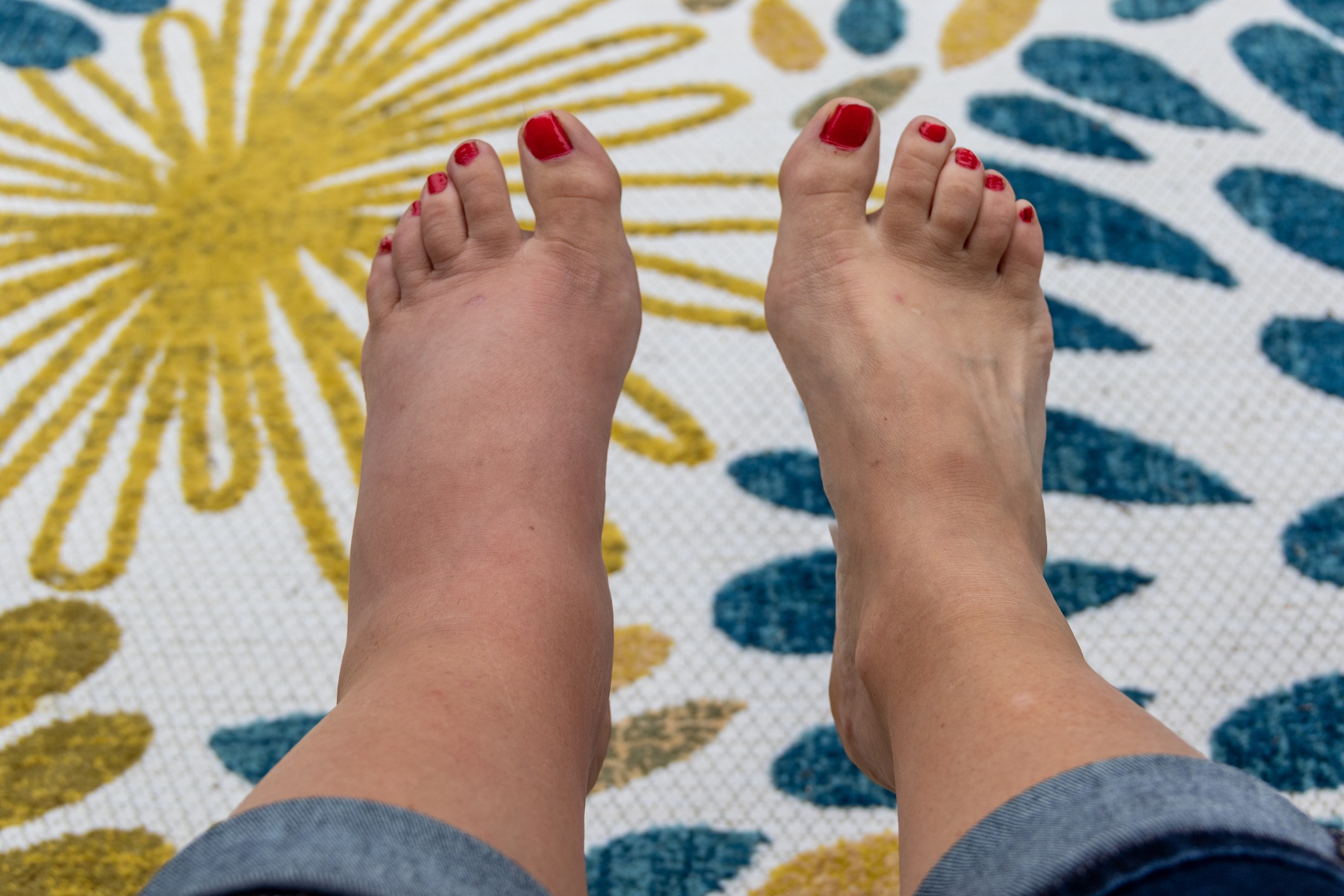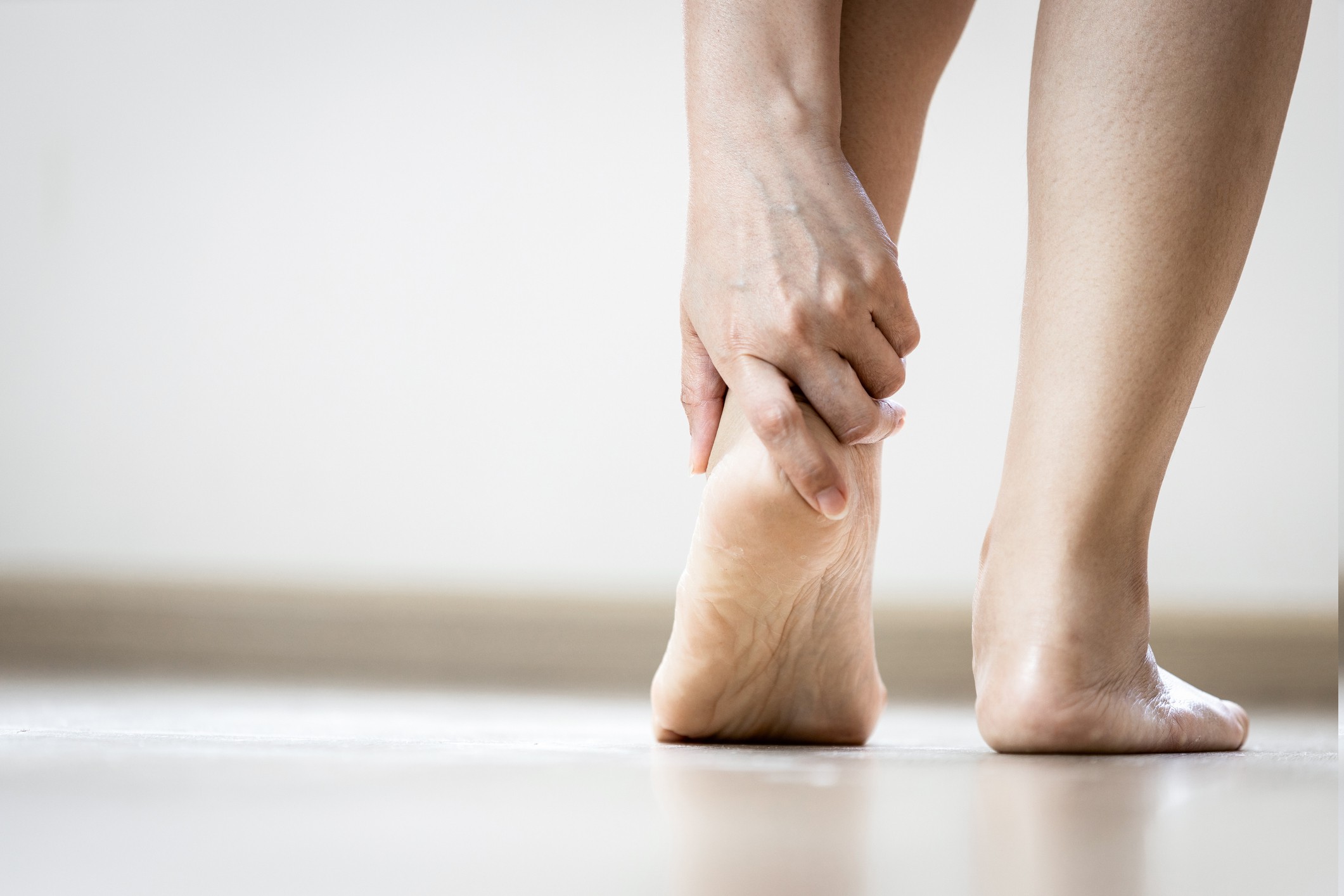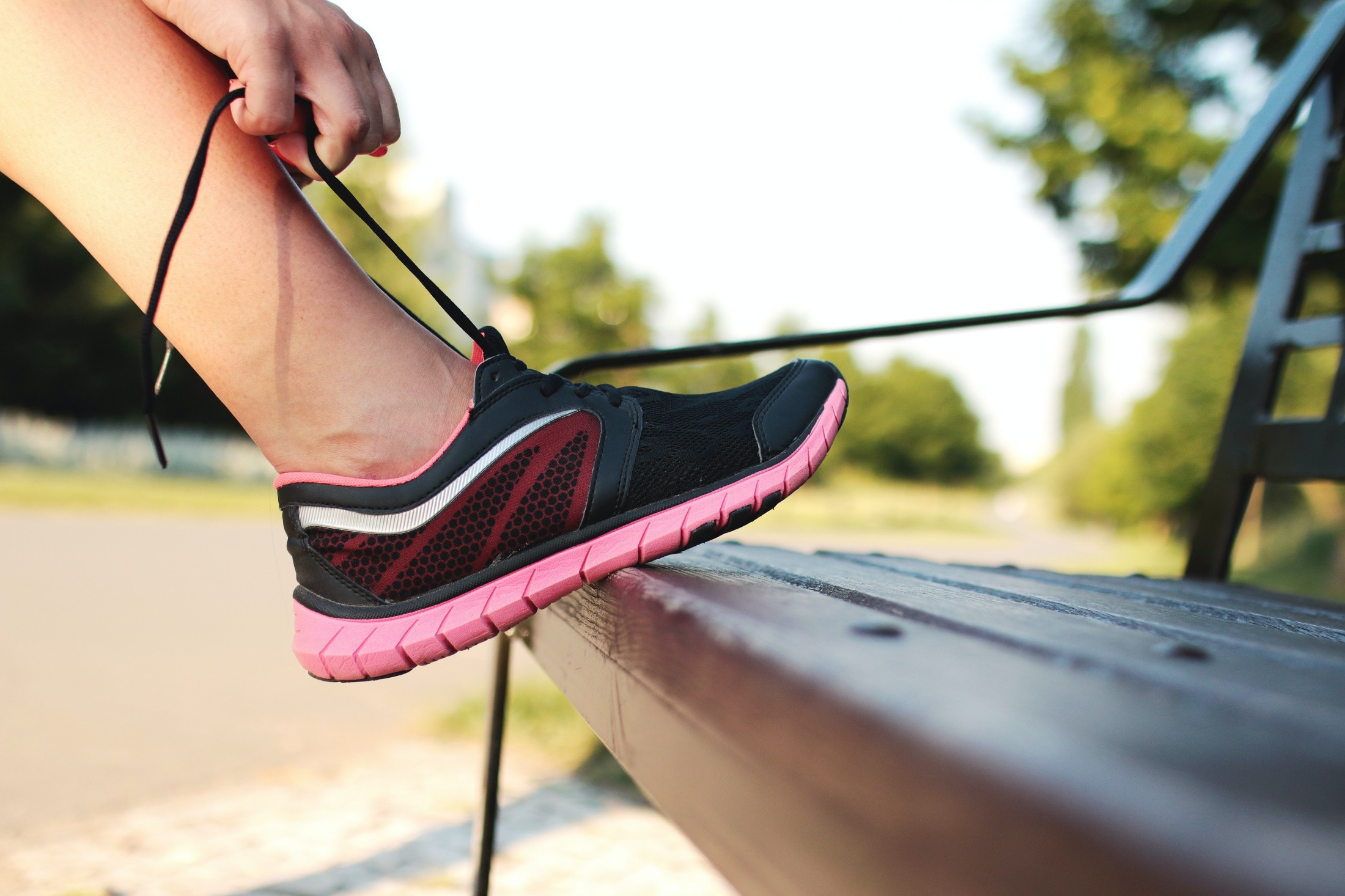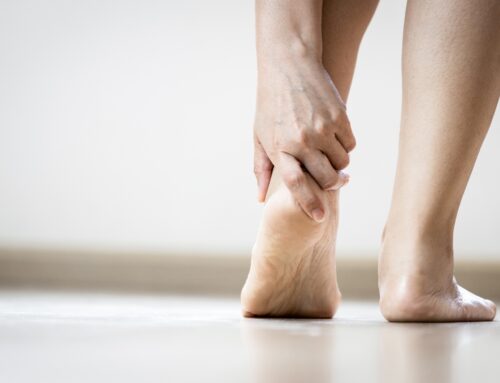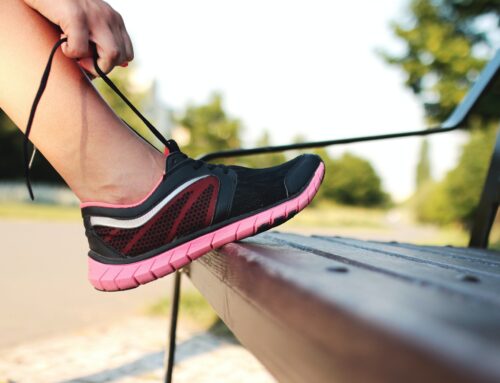Many people experience summer swelling, a common discomfort that occurs when warmer temperatures contribute to fluid buildup in the body. Edema, the medical term for swelling caused by excess fluid trapped in the tissues, can become more noticeable during hot weather. Heat causes blood vessels to expand, leading to increased fluid leakage into surrounding tissues, particularly in the feet, ankles, and legs.
Mild swelling in the summer is often temporary, but it can affect mobility and comfort and may signal underlying circulation or lymphatic issues.
Why Summer Swelling Happens
Summer swelling occurs because heat affects how the body manages circulation and fluids. When temperatures rise, blood vessels naturally expand, or dilate, to help release heat and cool the body. This widening of the blood vessels makes it easier for fluid to leak into nearby tissues, especially in the lower extremities like the feet, ankles, and legs.
The circulatory and lymphatic systems moves fluids back into the bloodstream. If either system is slowed or overwhelmed, fluid can accumulate, leading to swelling. For individuals with certain medical conditions, such as chronic venous insufficiency or lymphedema, the body’s ability to remove excess fluid is already reduced, making summer swelling more likely and more pronounced.
Other factors can also increase the risk of swelling during warm weather. People who are older, pregnant, heavier person, or who have underlying heart or kidney conditions may notice more persistent or severe swelling in the heat.
Common Causes of Swelling in Hot Weather
Several everyday factors can contribute to summer swelling or make it worse:
- Staying in one position for long periods can reduce circulation, allowing fluid to pool in the lower body.
- When the body is low on fluids, it may retain water as a protective response, leading to swelling.
- Conditions such as heart failure, kidney disease, or lymphedema can increase the likelihood of swelling in warm weather.
- Some medications, including certain blood pressure drugs, steroids, and hormone therapies, may contribute to fluid retention and swelling.
Recognizing the Signs of Summer Swelling
Summer swelling often develops gradually, and its symptoms can be easy to overlook until they begin to interfere with daily comfort. Being aware of early signs allows for timely intervention and helps prevent symptoms from becoming more severe.
Some of the most common signs of heat-related swelling include:
- Puffiness in the feet, ankles, or hands
Swelling often begins in the lower extremities due to gravity and reduced circulation, especially after long periods of standing or walking. Hands can also swell, particularly in hot, humid conditions or after outdoor activity. - Tightness or heaviness in the limbs
A swollen area may feel heavy or tight, making movement more difficult or uncomfortable. This sensation can intensify by the end of the day or after spending time in the sun. - Shoes or rings feeling too tight
Difficulty putting on shoes, sandals, or jewelry that normally fit comfortably is often one of the first noticeable symptoms of summer swelling. If your footwear or accessories feel restrictive without weight gain, fluid retention may be the cause
Ways to Manage Summer Swelling
Managing summer swelling often begins with simple lifestyle adjustments and self-care strategies that support healthy circulation and reduce fluid buildup. Small changes throughout the day can make a noticeable difference in reducing discomfort and preventing swelling from worsening.
Stay hydrated with water-rich foods and fluids
Staying well hydrated is one of the simplest yet most effective ways to help manage summer swelling. When the body doesn’t get enough water, it may start retaining fluids as a protective response, leading to increased swelling. Aim to drink water consistently throughout the day, rather than consuming large amounts all at once.
In addition to plain water, incorporating water-rich fruits and vegetables, such as watermelon, cucumber, strawberries, and celery, can boost hydration naturally. Avoiding excessive intake of caffeinated or alcoholic beverages, which can contribute to dehydration, is also important during the warmer months.
Elevate feet and legs during rest
Elevating your legs and feet above heart level encourages fluids to move back into the circulatory system and reduces the pooling of fluid in the lower extremities. Try lying down with your legs propped up on pillows or a wedge cushion for 15 to 30 minutes, several times a day.
This position can be especially beneficial after spending time standing or walking in hot weather. Incorporating leg elevation into your daily routine can help reduce swelling and prevent discomfort from becoming more pronounced by the end of the day.
Use compression socks or sleeves
Wearing compression socks or sleeves can provide support for circulation and fluid management, particularly for those prone to summer swelling. Compression garments apply graduated pressure to help move blood and lymphatic fluid back toward the heart, reducing the buildup of excess fluid in the legs, ankles, or arms.
Choose a compression level appropriate for your needs, and consider lighter, breathable fabrics designed for warm weather use. It’s best to put compression garments on in the morning before swelling increases, and wear them consistently throughout the day for optimal benefit.
Wear breathable footwear and clothing
Hot weather can make swelling worse if the body overheats or if clothing restricts circulation. Choosing lightweight, breathable shoes and clothing can minimize heat retention and allow the skin to stay cooler.
Footwear that offers support without being too tight is key, as tight shoes can constrict already swollen feet and worsen discomfort. Look for sandals or shoes with adjustable straps, mesh panels, or moisture-wicking materials to keep feet cool and reduce pressure on swollen areas.
Take short walks to improve circulation
Remaining sedentary for long periods allows fluids to pool in the lower body, contributing to summer swelling. Incorporating short walks throughout the day promotes healthy blood flow and stimulates the lymphatic system, which helps move excess fluid out of the tissues.
Even brief walks around the house or workplace every hour can make a difference. When possible, combine walking with gentle stretching or ankle flexion exercises to further support circulation and reduce swelling risk.
When to Use Compression Therapy
For many individuals, compression therapy can help with managing summer swelling. Compression garments, such as socks, sleeves, or wraps, apply gentle pressure to help improve circulation and reduce fluid buildup in the tissues.
Benefits of Compression for Summer Swelling
Although some may hesitate to wear compression gear in warm weather, compression can be especially helpful during the summer months when heat-related swelling is more common. Wearing compression:
- Supports healthy blood flow to prevent fluid from pooling in the lower limbs
- Reduces feelings of heaviness or fatigue in the legs and feet
- Helps manage symptoms of conditions like chronic venous insufficiency or lymphedema
Choosing the Right Level and Fit
Not all compression garments are the same. The level of compression you need depends on your health status and symptoms. Lower compression levels may be sufficient for mild summer swelling, while higher levels may be recommended for medical conditions.
A professional fitting can ensure the garment provides enough support without being too tight. Ill-fitting compression wear may feel uncomfortable or fail to provide adequate relief.
How to Wear Compression Gear Comfortably in Warm Weather
Wearing compression garments in the summer can feel challenging, but with the right approach, it’s possible to stay comfortable while still benefiting from compression therapy. Heat and humidity may make compression feel warmer or tighter than usual, so it’s important to choose products and routines that accommodate seasonal changes.
Selecting breathable fabrics, adjusting wear times, and paying attention to skin care can all help reduce discomfort and irritation. People who are new to compression therapy may find it helpful to gradually increase wear time to allow the body to adjust, especially during the hotter months:
- Choose lightweight, breathable fabrics designed for warmer climates
- Put on compression garments first thing in the morning, before swelling increases
- Avoid wearing compression that feels restrictive or causes skin irritation
- Pair compression gear with loose, breathable clothing to stay cool
When to Seek Medical Advice
While summer swelling is often temporary and manageable with self-care, it can sometimes be a sign of an underlying medical condition. Knowing when to consult a healthcare provider is important to ensure the swelling is not part of a more serious issue.
Signs That May Require Medical Attention
- Seek medical advice if you experience any of the following:
- Swelling that appears suddenly or affects only one side of the body
- Persistent or worsening swelling despite self-care
- Swelling accompanied by other symptoms
- Skin changes or open sores
Monitoring Patterns
Keeping track of when and how summer swelling occurs can help identify potential triggers and provide valuable insight for your healthcare provider. A journal noting time of day, activity level, weather conditions, and symptoms can support a more accurate diagnosis and treatment plan.
If you’re uncertain whether your symptoms are typical or more concerning, it’s always better to check with a medical professional. Early intervention can prevent complications and improve long-term comfort and mobility.
Products That Can Help With Summer Swelling
Managing summer swelling often involves incorporating specialized compression products into your daily routine. At Care-Med, we offer a range of medical-grade compression garments designed to improve circulation, reduce fluid retention, and alleviate discomfort associated with heat-induced swelling.
Compression Socks and Stockings
Compression socks and stockings apply graduated pressure to the legs, promoting blood flow back to the heart and preventing fluid accumulation in the lower extremities. These garments are particularly beneficial during warmer months when swelling tends to increase. Care-Med provides a variety of options tailored to individual needs and preferences.
Compression Sleeves
For those experiencing swelling in the arms or specific areas of the legs, compression sleeves offer targeted support. By applying consistent pressure, these sleeves help reduce edema and support muscle recovery. They are suitable for daily wear and can be an effective tool in managing summer swelling.
Pneumatic Compression Pumps
Pneumatic compression pumps provide intermittent pressure to limbs, enhancing lymphatic drainage and reducing significant swelling. These devices are especially useful for individuals with chronic conditions like lymphedema or those recovering from surgery.
Incorporating these compression products into your daily regimen can significantly alleviate the discomfort of summer swelling. For personalized recommendations and fittings, consider booking a consultation with Care-Med’s specialists.
Our team is here to help you choose the best solution and ensure the perfect fit for optimal comfort and results.
Share This Story, Choose Your Platform!
We specialize in orthotics, body braces, and compression wear tailored to your unique needs in Toronto. Reach out to us at info@caremed.care or call 416-782-5353 to book your fitting and consultation.
Experience the difference of customized solutions designed just for you.


